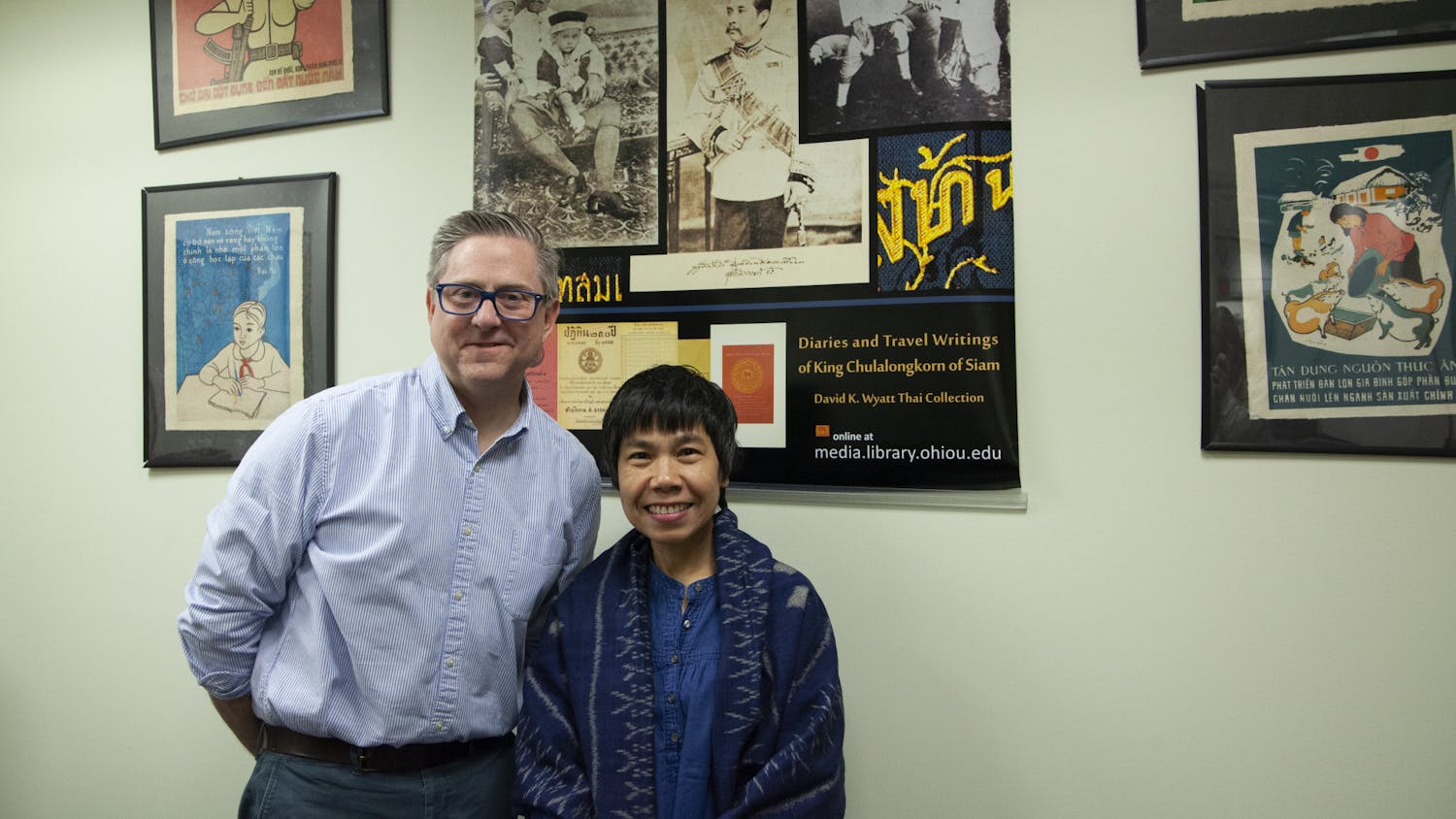While many across the nation lament the dip in arts attendance, Athens has found itself in a community where arts can thrive.
“Athens, Ohio, and Athens County is an arts-centric place,” said Maureen Wagner, assistant dean of the College of Fine Arts.
And though the arts might fare well in Athens, according to the 2012 Survey of Public Participation in the Arts, published by the National Endowment for the Arts, national attendance to arts events is declining.
Festivals Foster Attendance
As “melting pots” for entertainment acts, performing arts festivals have been gaining popularity around the nation, said Dominic Petrozzi, founder of #Fest.
“When you go to festivals, your eyes are opened up to certain demographics of music that you wouldn’t normally hear,” Petrozzi said.
And between the Nelsonville Music Festival, #Fest and Halftime Fest, Athens is becoming a bastion for outdoor music.
One of the few increases cited in the Survey of Public Participation in the Arts is an increase in outdoor performing arts festival attendance, up from 22 percent in 2008 to 25 percent in 2012.
The #Fests have seen a nearly 500 percent increase in attendance from 1Fest. Although having more nationally known acts such as Machine Gun Kelly in 2011 boosted numbers, attendance shrunk when Juicy J dropped out of 10Fest in the fall of 2012.
But despite the dips, the overall trend has been growth.
The Nelsonville Music Festival has also witnessed growth, though Brian Koscho, marketing director for Stuart’s Opera House, said attendance is dependent on the acts. Numbers skyrocketed in 2009 when Willie Nelson headlined, and grew even more in 2011 with The Flaming Lips and George Jones headlining. Yet 2010 saw decreased attendance and 2013 saw a smaller attendance with just 5,000 attendees, possibly because of the switch to semesters.
“Athens is such a unique little place on the map and art has played a role there for such a long time,” Petrozzi said. “We’re not the first, and we’re not going to be the last.”
Arts for Ohio Provides Access
In 2007, Ohio University identification cards became more than something that would get students into Ping or buy a meal; they began offering access to attend many College of Fine Arts events for free.
Arts for Ohio began because the cost of tickets seemed like an obstacle for students to attend, said Wagner, the project director for Arts for Ohio.
“It wasn’t just the financial part,” she said. “Students were also less likely to do something they hadn’t done before if they had to pay.”
From the very beginning of the initiative, Wagner said she saw an increase in attendance.
Arts for Ohio’s partnership with Learning Community programs can often lead to required attendance for College of Fine Arts events.
“If that’s the only way to get them to go, make them go,” said Ledger Free, front of house, box office and publicity manager for the College of Fine Arts. “It exposes kids to the greatest amount of art possible.”
According to the 2012 survey, musical attendance saw the first significant drop since the 1985 survey — a 9 percent rate of decline from 2008 to 2012.
Non-musical plays saw an even larger drop, with a 12 percent rate over the same period.
The Performing Arts Series has witnessed growth as well in the past few years. Andrew Holzaepfel, senior associate director for the Campus Involvement Center, attributes this increase to the variety of programming offered combined with the surveying of their audiences.
“With the Performing Arts Series and the College of Fine Arts, it’s about community connection,” Wagner said.
Art Houses Take a Hit
Although movie attendance increased this year from 53 percent in 2008 to 59 percent in 2012, “art houses” — small, artistically driven cinemas — are having a different problem.
The Athena Cinema has seen attendance rates grow in certain areas, but ticket sales have decreased in others, said Alexandra Kamody, managing director of the theater.
“Our special events are growing,” she said. “The Athens community is responding well to experiences that are more than just screenings but have a multimedia aspect to them.”
The theater’s recent Nosferatu screening, for example, which featured a live, original score by local band The Ridges, was nearly sold out.
Art houses across the nation struggle with the problem of competing against multiplexes — which can boast up to 20 screens — for audiences and clearances, or agreements between multiplexes and distribution houses to ensure nearby theaters don’t run the same films as the larger theater at the same time.
The Athena used to show independent films attached to directors like Wes Anderson or Woody Allen, but if nearby multiplexes are showing those films, the Athena cannot, Kamody said.
“Students really love cult classics, but it is no longer a given that the Athena will get to show those films,” she said.
Most of the Athena’s audience is a local crowd or senior citizens rather than students, which is normal for art houses where it is never a given there will be a great student turnout, Kamody said.
“The younger generation is a lot more apt to watch movies at home because of downloading or Netflix,” she said. “It’s sad because part of the experience is watching a movie in a theater with people.”
Bars and Bands
Art performances in Athens are not limited to just film or stage — bars also boast an eclectic range of performances.
Eric Gunn, owner of The Union Bar & Grill, 18 W. Union St., said attendance at the bar’s events have been solid every year.
“Athens is a very different market than New York City,” he said. “A lot of what we do is local and regional type bands, so they’re not really on the sort of national touring level.”
Though The Union has not had to raise its cover charge, which is normally between $2 to $5, attendance is dependent on the specific show. Free shows obviously get more of a crowd, Gunn said.
“Free shows get people coming out who might normally do something else,” he said. “Obviously when things are free, people take advantage of it.”
However, The Union has a maximum capacity of 250 people, so more popular bands would perform at the Templeton-Blackburn Alumni Memorial Auditorium or Stuart’s Opera House, which has the capacity to do so, Gunn said.
“We tend to have up-and-coming bands,” he said. “The White Stripes and The Black Keys both played here multiple times, but it was way long ago before they were big.”
Electronic Media Elevates Art
When listening to the radio, reading an e-book or watching a video online, users are consuming art electronically.
Though attendance at art events might have seen drops across the board since the 2008 survey, one of the few categories that experienced large growth was art consumption through electronic media.
In 2008, less than half — just 41 percent — of American adults accessed art via electronic media, including TV, the Internet and mobile devices. In the 2012 survey, however, that number jumped to 71 percent.
“It’s just the way of the world now,” Petrozzi said. “There are more opportunities to see and learn, whereas 10 or 15 years ago, if you weren’t in the market, you were in the dark.”
Sunil Iyengar, director of research and analysis at the National Endowment for the Arts, said this is the second year the survey has incorporated new media, but it is hard to say what the long-term implications are of technology’s influence on arts attendance.
“From the late ’90s up until now, we’ve seen attendance in the traditional arts activities drop,” Iyengar said. “We have found that people who engage in electronic media are two to three times more likely to attend arts activities than those who don’t.”
mg986611@ohiou.edu
@buzzlightmeryl
sm559111@ohiou.edu
@sophie_mitchem





